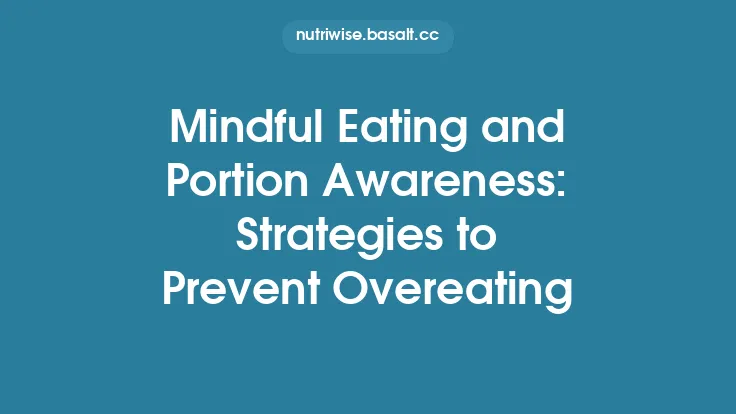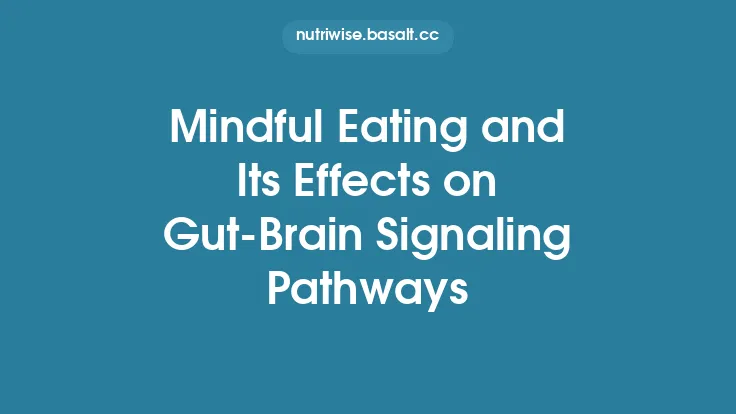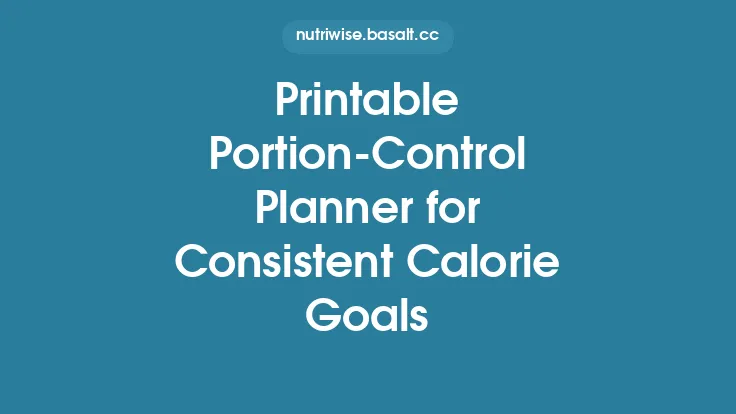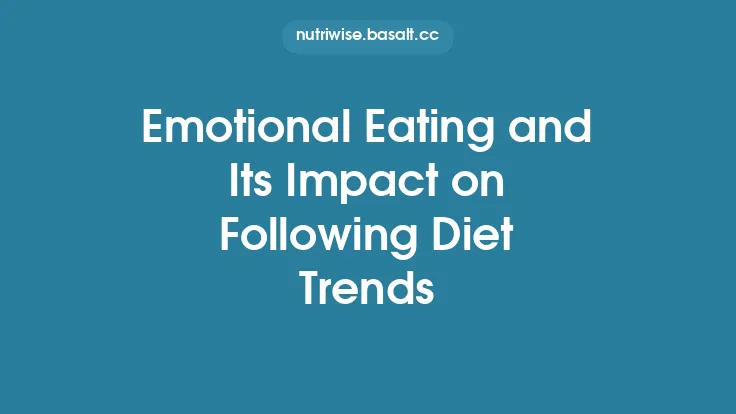Mindful eating is more than just choosing nutritious foods; it’s a practice that connects the act of eating with our internal signals, emotions, and overall well‑being. By systematically tracking hunger, satiety, and mood throughout the week, you can uncover hidden patterns, make more intentional food choices, and cultivate a healthier relationship with food. This article walks you through the philosophy behind mindful eating, the essential elements of a weekly planner designed for this purpose, and practical strategies for turning raw data into actionable insights.
Why Mindful Eating Matters
The Science of Interoception
Interoception refers to the body’s ability to sense internal physiological states—such as hunger, fullness, and emotional arousal. Research shows that individuals with heightened interoceptive awareness tend to make more balanced food choices, experience fewer episodes of overeating, and report higher overall satisfaction with meals. A mindful eating planner serves as a structured tool to sharpen this internal listening skill.
Emotional Eating vs. Responsive Eating
Emotions can hijack the brain’s reward pathways, prompting us to reach for food as a coping mechanism rather than a source of nourishment. By logging mood alongside hunger and satiety, you create a visual map that distinguishes emotional triggers from genuine physiological needs. Over time, this distinction helps you replace reflexive, emotion‑driven snacking with more responsive, purpose‑driven eating.
Long‑Term Health Benefits
Consistently aligning intake with true hunger and satiety cues can aid weight management, improve blood glucose stability, and reduce the risk of chronic conditions such as metabolic syndrome. Moreover, the reflective component of mood tracking supports mental health by encouraging mindfulness, reducing stress, and fostering a sense of agency over one’s eating habits.
Core Components of a Mindful Eating Planner
| Component | What It Captures | Why It’s Important |
|---|---|---|
| Date & Meal Slot | Day of the week and specific eating occasion (e.g., Breakfast, Snack, Dinner) | Provides temporal context for patterns (e.g., “I’m always low on energy mid‑afternoon”). |
| Hunger Rating | 0–10 scale (0 = not hungry, 10 = ravenously hungry) | Quantifies physiological drive before eating. |
| Satiety Rating | 0–10 scale (0 = still hungry after eating, 10 = completely satisfied) | Measures how well the meal met energy needs. |
| Mood Check‑In | Simple descriptors (e.g., Calm, Stressed, Anxious, Joyful) or a 1–5 intensity scale | Links emotional state to eating behavior. |
| Food Log (Brief) | Main food items, portion size, and any notable ingredients | Allows correlation between specific foods and subsequent hunger/satiety/mood. |
| Reflection Prompt | “What influenced my eating today?” (optional free‑text) | Encourages deeper self‑analysis and reinforces learning. |
These elements together create a holistic snapshot of each eating episode, enabling you to see not just *what you ate, but why you ate it and how* it affected you.
Designing Your Weekly Tracker
1. Choose a Layout That Fits Your Lifestyle
- Grid Format – Ideal for printable planners; each row represents a meal, each column a tracking variable.
- Columnar Journal – Works well in digital note‑taking apps; you can collapse or expand sections as needed.
- Hybrid Calendar – Combines a weekly calendar view with embedded tracking boxes for quick reference.
2. Standardize Scales for Consistency
- Hunger & Satiety: Adopt a 0–10 numeric scale. Provide brief anchor points (e.g., 0 = “starved,” 5 = “moderately hungry,” 10 = “extremely full”) to reduce subjective drift over time.
- Mood: Use a 5‑point Likert scale (1 = Very Negative, 5 = Very Positive) paired with a short list of common emotions. This balances granularity with ease of entry.
3. Allocate Space for “What If” Scenarios
Include a small margin column where you can note potential adjustments (e.g., “Add protein next time” or “Swap sugary snack for fruit”). This turns the planner into a living experiment rather than a static log.
4. Color‑Code for Quick Visual Cues
- Red for high hunger (>7) before meals.
- Green for high satiety (>7) after meals.
- Yellow for neutral mood (3–4).
These visual cues let you spot trends at a glance without reading every entry.
Integrating Hunger, Satiety, and Mood Ratings
A. Synchronizing the Timing of Entries
- Pre‑Meal: Record hunger and current mood *immediately* before you start eating.
- Post‑Meal: Within 15–30 minutes after finishing, note satiety and any shift in mood. This window captures the immediate physiological response before external factors (e.g., work tasks) intervene.
B. Linking Food Composition to Outcomes
- Macronutrient Influence: Protein and fiber tend to raise satiety scores, while high‑glycemic carbs may cause a rapid rise in hunger a few hours later.
- Micronutrient & Hydration Effects: Deficiencies (e.g., magnesium) or dehydration can manifest as irritability or low energy, reflected in mood ratings.
C. Using the Data for Predictive Adjustments
After two weeks of consistent logging, calculate average hunger and satiety scores for each meal type. If breakfast consistently yields a satiety score ≤4, consider adding a protein source (e.g., Greek yogurt, eggs) or healthy fat (e.g., avocado). Similarly, if mood drops after lunch, examine whether the meal was overly processed or lacking in complex carbs.
Interpreting the Data: Patterns and Insights
1. Heat‑Map Analysis
Create a simple heat‑map in a spreadsheet: rows = days, columns = meals, cell color = average hunger or satiety rating. Hot spots (red) highlight meals where hunger remains high; cool spots (blue) indicate successful satiety.
2. Correlation Coefficients
Use basic statistical tools (e.g., Pearson correlation) to explore relationships:
- Hunger ↔ Satiety: A strong negative correlation suggests meals are meeting needs.
- Satiety ↔ Mood: Positive correlation may indicate that feeling full contributes to better mood, or vice versa.
3. Trend Lines Over Weeks
Plot weekly averages for each variable. A downward trend in hunger scores before dinner could signal that earlier meals are more balanced, while an upward trend in negative mood after snacks may flag emotional eating triggers.
4. Qualitative Themes from Reflections
Review free‑text notes for recurring themes such as “stress at work,” “social gatherings,” or “late‑night cravings.” Tag these themes and cross‑reference with quantitative data to see how external factors influence internal cues.
Tips for Consistent Use
- Set a Daily Reminder: A phone alarm at typical meal times prompts you to log before and after eating.
- Keep the Planner Accessible: If you use a printable version, place it on the kitchen counter; for digital, pin the note to your home screen.
- Start Small: In the first week, focus only on hunger and satiety. Add mood tracking in week two once the habit feels natural.
- Review Weekly, Not Daily: Reserve a 15‑minute slot each Sunday to analyze the week’s data; daily over‑analysis can become overwhelming.
- Celebrate Micro‑Wins: Note any improvement (e.g., “Satiety after lunch increased from 5 to 7”) to reinforce positive behavior.
Adapting the Planner to Different Diets and Lifestyles
| Lifestyle | Adjustments to Planner |
|---|---|
| Plant‑Based | Include a column for “Protein Source” (legumes, tofu, tempeh) to monitor its impact on satiety. |
| Athletic/High‑Performance | Add a “Pre‑Workout Fuel” row and a “Post‑Workout Recovery” row, tracking specific timing of meals relative to training. |
| Shift Workers | Use a 24‑hour clock for meal slots and add a “Sleep Quality” rating to explore the interplay between circadian rhythm, hunger, and mood. |
| Pregnancy & Postpartum | Incorporate a “Craving Intensity” scale (0–5) to capture hormonal influences on appetite. |
| Elderly | Emphasize “Texture” and “Ease of Chewing” columns, as oral health can affect satiety perception. |
The core structure remains the same; only the contextual fields shift to reflect unique nutritional needs and lifestyle constraints.
Digital vs. Printable Formats
Digital Advantages
- Automatic Calculations: Instant averages, trend graphs, and correlation outputs.
- Portability: Sync across devices; log on the go.
- Searchability: Quickly locate specific meals or mood entries.
Printable Advantages
- Tactile Engagement: Writing by hand can enhance mindfulness and memory retention.
- No Battery Dependency: Ideal for kitchens where devices may be inconvenient.
- Customizable Layout: Easy to draw additional symbols or doodles that capture nuance.
A hybrid approach works for many: use a printable sheet for the immediate meal log, then transfer the data weekly into a digital spreadsheet for deeper analysis.
Common Pitfalls and How to Avoid Them
| Pitfall | Why It Happens | Solution |
|---|---|---|
| Rating Fatigue | Too many entries per day lead to rushed or inaccurate scores. | Limit to pre‑ and post‑meal entries only; skip optional reflection on low‑impact days. |
| Scale Drift | Over time, “5” may feel like “3” as perception changes. | Re‑calibrate weekly by revisiting anchor definitions; use visual analog scales if helpful. |
| Over‑Analyzing Minor Variations | Small day‑to‑day fluctuations can cause unnecessary worry. | Focus on trends over 2‑3 weeks; treat single outliers as data points, not conclusions. |
| Neglecting Context | Logging food without noting stressors or activity can mislead interpretations. | Always fill the mood or reflection column, even with a single word (“busy”). |
| Inconsistent Timing | Logging after a delay skews satiety scores. | Set a timer for 15 minutes post‑meal to remind you to record. |
By anticipating these challenges, you keep the planner a supportive tool rather than a burdensome chore.
Resources and Further Reading
- Books: *“Mindful Eating: A Guide to Rediscovering a Healthy and Joyful Relationship with Food”* by Jan Chozen Bays, PhD.
- Scientific Articles: “Interoceptive Awareness and Eating Behavior” – *Appetite* journal, 2022.
- Apps: “Eat Right Now” (offers hunger/satiety scales), “Moodpath” (integrates mood tracking).
- Websites: The Center for Mindful Eating (mindfuleating.org) provides free worksheets and research summaries.
- Podcasts: “The Nutrition Diva” episodes on intuitive eating and emotional eating.
These resources can deepen your understanding of the concepts behind the planner and provide additional tools for sustained mindful eating practice.
By systematically recording hunger, satiety, and mood each week, you create a feedback loop that sharpens self‑awareness, guides smarter food choices, and supports overall well‑being. Whether you prefer a printable sheet on your kitchen counter or a sleek digital dashboard, the mindful eating weekly planner is a versatile, evergreen instrument for anyone seeking a more intentional, balanced relationship with food. Happy tracking!



